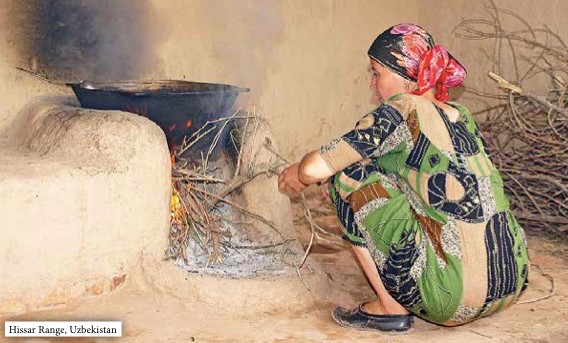Central Asia comprises a vast area stretching from the Western Siberian lowlands to the Tian Shan and Pamir mountain ranges and from the Altai to the Caspian Sea. Its topography is characterized by vast deserts and mountainous regions. In total, 20 percent of the approximately four million square kilometres that make up Central Asia is covered by mountains. The region’s location in the centre of the Eurasian landmass, far from humid ocean currents, determines its arid climate and results in a rich diversity of landscapes,with more than twenty different ecosystems. Because of these specific features, the countries of Central Asia – Kazakhstan, Kyrgyzstan, Tajikistan, Turkmenistan and Uzbekistan – are among those most vulnerable Executive Summary to climate change, which manifests in a rising annual average temperature. Such raise in temperature will have a mainly negative impact on the region. According to the research conducted by the World Bank in 2009 in 28 countries in Europe, the Caucasus and Central Asia, Tajikistan and Kyrgyzstan have the highest degree of vulnerability to climate change. This is an alarming trend, highlighting the particular vulnerability of the mountain ecosystems of Central Asia to climate change in comparison to other mountainous regions of the Eurasian continent. Global climate change influences glaciers and water resources in the region’s mountain areas. It presents an acute and urgent need to research and analyse the impact of climate change on humans, ecosystems and economies of countries in the region, and to consider what climate change related policies these countries should adopt.
The Outlook is one of the outcomes of the “Climate change action in developing countries with fragile mountainous ecosystems from a sub-regional perspective” project, which is being implemented by the United Nations Environment Programme (UN Environment) with support from the Government of Austria. This project seeks to support mountainous countries in five sub-regions (Central Asia, East Africa, South Caucasus, Tropical Andes and Western Balkans) to integrate climate change adaptation issues into their development strategies, plans and programmes. The partners of UN Environment in preparing the Outlook for Central Asia were: Regional Mountain Centre for Central Asia (RMCCA) and GRID-Arendal. The Outlook focuses on the impacts of climate change on people, ecosystems and the economies of the Central Asian countries and proposes that a development of climate change policies in these countries is essential. The Outlook synthesizes the existing information on current trends and challenges in terms of climate change adaptation in mountain regions of Central Asia, based on the most recent academic literature as well as on consultations with various governmental and non-governmental experts from the Central Asian region and beyond. It identifies gaps and concrete needs in terms of climate change adaptation and provides a set of recommendations for concrete policy action.
Adaptation to climate change is not only of concern to ecologists, it touches upon all aspects of human activity and will therefore have an impact on every economic sector in the region. This report highlights the close interrelationship between ecosystems and sectors of the economy (energy, agriculture, mining, tourism) which are vulnerable to climate change, as well as health issues in the context of the impact of climate change. Some countries in the region are attempting to develop sectoral programmes and action plans to mitigate and adapt to climate change. The implementation of such programmes and plans however, remains at an early stage. What’s more, This Outlook reveals a low level of awareness among local communities and farmers with regards to both climate change and adaptation.
The Central Asian countries will meet in April, 2018 for further practical actions based on recommendations of the Outlook, including development of Strategic Guidance which will propose an approach for regional cooperation on adaptation in Central Asian mountainous areas. In particular, it will include a list of possible programmatic priority actions that are necessary to reduce the risks as well as to seize the opportunities created through climate change. The Strategic Guidance aims to overcome adaptation gaps and should provide added value to existing initiatives in this field. In addition, the Strategic Guidance aims to create the basis for a solid and detailed Action Plan on climate change adaptation in mountainous regions of Central Asia, to obtain as well as strengthen the commitment of the Central Asian governments to elaborate such a plan in the framework of a future project. The Strategic Guidance will also provide strong input to the Central Asian Regional Environmental Action Plan (REAP) update process.
For more detailed information, please click here to download the full article.

